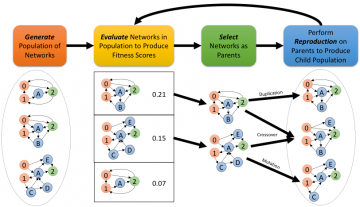
Achievement
A team of researchers at Oak Ridge National Laboratory (ORNL) and the University of Tennessee presented an improvement to an algorithmic approach called Evolutionary Optimization for Neuromorphic Systems (EONS) that enables rapid prototyping of new applications of spiking neural networks in neuromorphic systems. They presented several case studies of how EONS can be used, including to train spiking neural networks for classification and control tasks, to train under hardware constraints, to evolve a reservoir for a liquid state machine, and to evolve smaller networks using multi-objective optimization.
Significance and Impact
This work demonstrates how EONS can make neuromorphic systems more accessible to new users of neuromorphic computing, increasing the likelihood of wide adoption of neuromorphic systems. It demonstrates how EONS can be used by neuromorphic hardware developers to facilitate a hardware co-design process, which will allow for innovations in the development of new materials and devices for neuromorphic hardware implementation. Finally, it demonstrates how EONS can be used by neuromorphic algorithm researchers in order to better understand and to optimize their algorithmic approaches.
Research Details
- Researchers demonstrate a software framework called EONS that can be used to rapidly prototype new applications of spiking neural networks on neuromorphic hardware, and for the first time, showed the Python implementation of EONS, which will enable better ease of use for new researchers.
- Researchers demonstrated that EONS can be applied to multiple types of tasks (e.g., classification, control, etc.) without altering the underlying algorithm.
- Researchers demonstrated that EONS can operate within the constraints and characteristics of a hardware implementation and can be used as part of the co-design process in understanding design trade-offs.
- Researchers demonstrated that EONS can be used in combination with other training approaches, such as reservoir computing.
- Researchers demonstrated that EONS can be augmented with a multi-objective optimization approach so that it can evolve more size efficient spiking neural networks for deployment on neuromorphic hardware.
Citation and DOI
Catherine D. Schuman, J. Parker Mitchell, Robert M. Patton, Thomas E. Potok and James S. Plank. "Evolutionary Optimization for Neuromorphic Systems." Neuroscience-Inspired Computational Elements (NICE) Workshop 2020.
Overview
Designing and training an appropriate spiking neural network for neuromorphic deployment remains an open challenge in neuromorphic computing. In 2016, researchers from ORNL introduced an approach for utilizing evolutionary optimization to address this challenge called Evolutionary Optimization for Neuromorphic Systems (EONS). In this work, the same researchers present an improvement to this approach that enables rapid prototyping of new applications of spiking neural networks in neuromorphic systems. The researchers discuss the overall EONS framework and its improvements over the previous implementation, and present several case studies of how EONS can be used, including to train spiking neural networks for classification and control tasks, to train under hardware constraints, to evolve a reservoir for a liquid state machine, and to evolve smaller networks using multi-objective optimization.
Last Updated: January 14, 2021 - 8:59 pm